I’ve been writing Top 10 Albums of the Year lists for over 10 years now, but this year marks 10 years of lists which are published on the internet. If you’d like to take a walk down memory lane, go for it:
2006 | 2007 | 2008 | 2009 | 2010 | 2011 | 2012 | 2013 | 2014 | 2015
One of the most amazing parts about this, to me, is that all the links still work, across Facebook Notes, Tumblr and for the last 6 years, this very website here. Things have broken though: images embedded from elsewhere on the web, all download links, and who knows what else.
Well, I like data so I decided to take this 10 year milestone as a chance to draw as much as I can out of these top 10 lists. So I made a Google Sheet and I went to work.
Here are some charts. Some have some explanation and others should be more self explanatory. Click on the charts to see bigger versions with interactive data in a new tab.
Does my list contain popular opinions?
Are the opinions on my list widely held? This first chart aims to find out. I put in the Metacritic scores for all 100 albums on my list (when available) and averaged them out for each year. Some years 2-3 albums weren’t available so there are less than 100 data points to work with here.
My list is pretty steady from year to year with my “least popular list” at an average score of 76.1 and 3 of my most popular lists all topping out just above 81.5. Metacritic states that a score of 81-100 is “universally acclaim” and 61-80 indicated “Generally Favorable Reviews”. I put a trend line in there as well which seems to indicate that things are getting more popular:
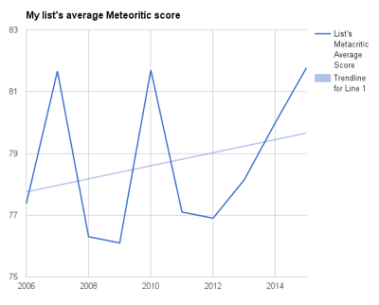
Some other trends
Here I took 5 different data points and put them all on one confusing chart.
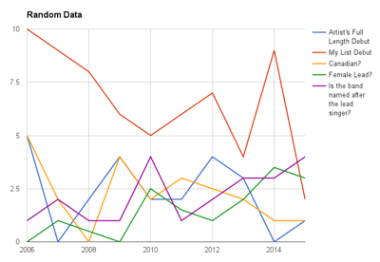
The red line indicates how many artists made their first appearance on my list that year. Obviously, the first year, that would be all 10 of them.
The blue line indicates how many new artists have showed up on my list that year. This line is troubling because it’s definitely trending downward, meaning I’m listening to less new artists. Boo Jon.
The other three lines are demographics: How Canadian is my list? How female is it? And how many entries on my list are by eponymous artists?
That first chart was a little cluttered, so I made another one that is a 3 year average (one year before, one year after, when data is available):
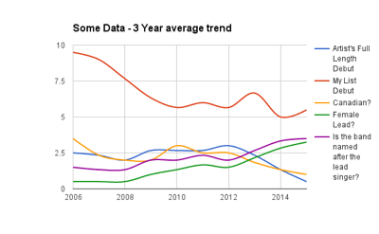
The Regulars
The last 3 charts attempt to visualize some of my favorite artists of the last 10 years by documenting how frequently they show up on my list, how they rank in the top 10 and finally if they are in multiple bands throughout the years.
Here are all the bands that appear more than once:
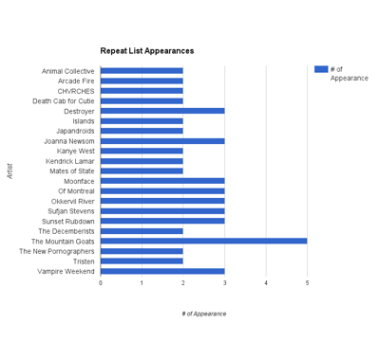
Here are how bands with multiple appearances usually rank (shorter bars are best here):

And finally here are the individuals who are leads or co-leads in multiple bands that appear on the list:
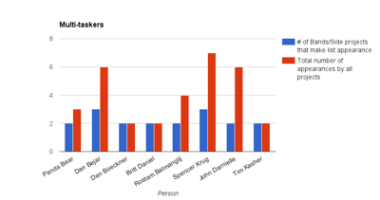
For clarification:
Panda Bear is in Panda Bear & Animal Collective.
Dan Bejar is in Destroyer, The New Pornographers and Swan Lake.
Dan Boeckner is in The Handsome Furs, Divine Fits and Wolf Parade (though Wolf Parade never appears on this list!)
Britt Daniel is in Divine Fits and Spoon.
Rostam Batmanglij is in Vampire Weekend (though probably a bit of a stretch to call him a lead) and Discovery.
Spencer Krug is in Sunset Rubdown, Moonface, Swan Lake and lots of other bands that aren’t on this list.
John Darnielle is in The Mountain Goats and Extra Lens which I think was a 1-off project.
And Tim Kasher is in The Good Life, Cursive (not on any of these lists!) and of course, Tim Kasher.
There were a couple surprises for me in this chart:
Anyway. That’s all for now. The data is available to anyone who’d like to look at it on Google Drive!
December 23, 2016 at 12:33 pm
[…] Here’s updated data from 2015. Not tracking any new metrics, but you can read last year’s post for more context here. […]